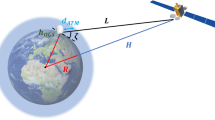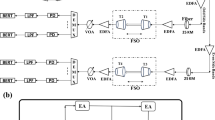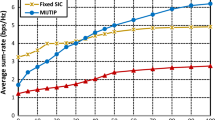Abstract
Internet of Things (IoT) enables the inter-connectivity of different “things” using which wide range of items and devices can communicate with each other and their external environment. 5G technology offers enhanced quality of service with high-data transmission rates, which necessitates the implementation of IoT in 5G architecture. Free space optics (FSO) is considered as a promising technology that can offer high-speed information transmission links and therefore is an optimal choice for wireless networks to satisfy the full potential of 5G technology offering 100 Gbit/s or more speed. By implementing 5G features in IoT, the coverage area and performance of IoT will be enhanced using high-speed FSO links. This work proposes the development of high-speed long-reach FSO link for the implementation of 5G and IoT. We investigate a long-haul, single-channel polarization division multiplexed 16-level quadrature amplitude modulation (PDM-16-QAM) based FSO link at 160 Gbit/s incorporating digital signal processing with coherent detection at the receiver terminal. The results show that the proposed system demonstrates a good bit error rate performance under different weather conditions. The proposed system can be deployed for high-speed, long-haul, spectral efficient, robust information transmission links in future 5G wireless networks under dynamic weather conditions.








Similar content being viewed by others
References
Singh, D., Tripathi, G., Jara, A. J. (2014). A survey of internet-of-things: future vision, architecture, challenges and services. In: Proceedings of IEEE World Forum on Internet of Things 2014, at Seoul, pp. 287–292.
Miraz, M. H., Ali, M., Excell, P. S., & Picking, R.: A review on Internet of Things (IoT), Internet of Everything (IoE) and Internet of Nano Things (IoNT). In 2015 Internet Technologies and Applications (ITA), Wrexham, pp. 219–224.
Condoluci, M., Araniti, G., Mahmoodi, T., & Dohler, M. (2016). Enabling the IoT machine age with 5G: machine-type multicast services for innovative real-time applications. IEEE Access,4, 5555–5569.
Gupta, A., & Jha, R. K. (2015). A survey of 5G network: Architecture and emerging technologies. IEEE Access,3, 1206–1232.
Al-Fuqaha, A., Guizani, M., Mohammadi, M., Aledhari, M., & Ayyash, M. (2015). Internet of Things: A survey on enabling technologies, protocols, and applications. IEEE Communications Surveys & Tutorials,17(4), 2347–2376.
Palattella, M. R., et al. (2016). Internet of Things in the 5G Era: Enablers, architecture, and business models. IEEE Journal on Selected Areas in Communications,34(3), 510–527.
Čolaković, Alem, & Hadžialić, Mesud. (2018). Internet of Things (IoT): A review of enabling technologies, challenges, and open research issues. Computer Networks,144, 17–39.
Majumdar, A. K. (2019). Chapter 8—Free-space optical communications: role and integration with the Internet of Things. In A. K. Majumdar (Ed.), Optical wireless communications for Broadband Global Internet Connectivity (pp. 245–258). Amsterdam: Elsevier.
Singh, J., & Kumar, N. (2013). Performance analysis of different modulation format on free space optical communication system. Optik-International Journal of Light and Electron Optics,124(20), 4651–4654.
Khalighi, M. A., & Uysal, M. (2014). Survey on free space optical communication: A communication theory perspective. IEEE Communications Surveys & Tutorials,16(4), 2231–2258.
Badar, N., Jha, R., & Towfeeq, I. (2018). Performance analysis of 80 (8 × 10) Gbps RZ-DPSK based WDM-FSO system under combined effects of various weather conditions and atmospheric turbulence induced fading employing Gamma-Gamma fading model. Optical and Quantum Electronics,50, 1–11.
Jeyaseelan, J., Kumar, S., & Caroline, B. (2018). PolSK and ASK modulation techniques based BER analysis of WDM-FSO system for under turbulence conditions. Wireless Personal Communications,103(4), 3221–3237.
Jeyaseelan, J., Kumar, S., & Caroline, B. (2018). Performance analysis of free space optical communication system employinh WDM-PolSK under turbulent weather conditions. Journal of Optoelectronics and Advanced Materials,20(9), 506–514.
Chaudhary, S., Amphawan, A., & Nisar, K. (2014). Realization of free space optics with OFDM under atmospheric turbulence. Optik,125(18), 5196–5198.
Kaur, G., Srivastava, D., Singh, P., & Parasher, Y. (2019). Development of a novel hybrid PDM/OFDM technique for FSO system and its performance analysis. Optics & Laser Technology,109, 256–262.
Chaudhary, S., & Amphawan, A. (2018). Solid core PCF-based mode selector for MDM-Ro-FSO transmission systems. Photonic Network Communications,36(2), 263–271.
Chaudhary, S., & Amphawan, A. (2018). Selective excitation of LG 00, LG 01, and LG 02 modes by a solid core PCF based mode selector in MDM-Ro-FSO transmission systems. Laser Physics,28(7), 1–8.
Amphawan, A., Chaudhary, S., & Chan, V. (2019). Optical millimeter wave mode division multiplexing of LG and G modes for OFDM Ro-FSO system. Optics Communications,431, 245–254.
Sarangal, H., Singh, A., Malhotra, J., & Chaudhary, S. (2017). A cost effective 100Gbps hybrid MDM-OCDMA-FSO transmission system under atmospheric turbulences. Optical and Quantum Electronics,49, 184.
Makovejs, S., Millar, D. S., Mikhailov, V., Gavioli, G., Killey, R. I., Savory, S. J., et al. (2010). Novel method of generating QAM-16 signals at 21.3 Gbaud and transmission over 480 km. IEEE Photonics Technology Letters,22(1), 36–38.
Mori, Y., Zhang, C., Igarashi, K., Katoh, K., & Kikuchi, K. (2009). Unrepeated 200-km transmission of 40-Gbit/s 16- QAM signals using digital coherent receiver. Optics Express,17(3), 1435–1441.
Charlet, G., Renaudier, J., Mardoyan, H., Tran, P., Pardo, O. B., Verluise, F., et al. (2009). Transmission of 16.4-Tbit/s capacity over 2550 km using PDM QPSK modulation format and coherent detection. Journal of Lightwave Technology,27(3), 153–157.
Renaudier, J., Charlet, G., Bertran-Pardo, O., Mardoyan, H., Tran, P., Salsi, M., et al. (2009). Transmission of 100 Gb/s coherent PDM-QPSK over 16 x 100 km of standard fiber with allerbium amplifiers. Optics Express,17(7), 5112–5119.
Winzer, P. J., Gnauck, A. H., Doerr, C. R., Magarini, M., & Buhl, L. L. (2010). Spectrally efficient long-haul optical networking using 112-Gb/s polarization-multiplexed 16-QAM. Journal of Lightwave Technology,28(4), 547–556.
Sano, A., Masuda, H., Kobayashi, T., Fujiwara, M., Horikoshi, K., Yoshida, E., et al. (2010). 69.1-Tb/s (432 × 171-Gb/s) C- and Extended L-band transmission over 240 km using PDM-16-QAM modulation and digital coherent detection. In Proceedings of OFC, paper PDPB7, Sam Diego, USA.
Jain, D., & Mehra, R. (2017). Performance of 120 Gbps single and dual polarized 16-QAM coherent FSO systems under various turbulence regimes. In 2017 International Conference on Computing and Communication Technologies for Smart Nation (IC3TSN), Gurgaon, pp. 89–94.
Zhou, X., & Yu, J. (2009). Digital signal processing for coherent optical communication. In 18th Annual Wireless and Optical Communications Conference, Newark, NJ, pp. 1–5.
Zhong, K., Zhou, X., Huo, J., Yu, C., Lu, C., & Lau, A. P. T. (2018). Digital signal processing for short-reach optical communications: A review of current technologies and future trends. Journal of Lightwave Technology,36(2), 377–400.
Tsukamoto, S., Katoh, K., & Kikuchi, K. (2006). Unrepeated 20-Gbit/s QPSK transmission over standard single-mode fiber using homodyne detection and digital signal processing for dispersion compensation. In Optical Fiber Communication Conference and the National Fiber Optic Engineers Conference, Anaheim, CA.
Raju, M., & Reddy, K. A. (2016). Evaluation of BER for AWGN, Rayleigh fading channels under M-QAM modulation scheme. In International conference on electrical, electronics, and optimization techniques (ICEEOT), Chennai, pp. 3081–3086.
Sklar, B. (2001). Digital communications: Fundamentals and applications. Englewood Cliffs: Prentice Hall.
Kolev, D. R., Wakamori, K., & Matsumoto, M. (2012). Transmission analysis of OFDM-based services over line-of-sight indoor infrared laser wireless links. Journal of Lightwave Technology,30, 3727–3735.
Ciblat, P., & Vandendorpe, L. (2003). Blind carrier frequency offset estimation for noncircular constellation-based transmissions. IEEE Transactions on Signal Processing,51, 1378–1389.
Zhou, X., Zhong, K., Gao, Y., Lu, C., Lau, A. P. T., & Long, K. (2014). Modulation-format-independent blind phase search algorithm for coherent optical square M-QAM systems. Optics Express,22, 24044–24054.
Karaki, J., Giacoumidis, E., Grot, D., Guillossou, T., Gosset, C., Le Bidan, R., et al. (2013). Dual-polarization multi-band OFDM versus single-carrier DPQPSK for 100 Gb/s long-haul WDM transmission over legacy infrastructure. Optics Express,21, 16982.
Acknowledgement
The authors would like to express their sincere thanks to Prof. Dr. Truong Khang Nguyen, Division of Computational Physics, Institute for Computational Science, Ton Duc Thang University, Ho Chi Minh City, Vietnam for giving his value suggestion, comments and support to complete this work as effective.
Author information
Authors and Affiliations
Corresponding author
Additional information
Publisher's Note
Springer Nature remains neutral with regard to jurisdictional claims in published maps and institutional affiliations.
Rights and permissions
About this article
Cite this article
Dhasarathan, V., Singh, M. & Malhotra, J. Development of high-speed FSO transmission link for the implementation of 5G and Internet of Things. Wireless Netw 26, 2403–2412 (2020). https://doi.org/10.1007/s11276-019-02166-5
Published:
Issue Date:
DOI: https://doi.org/10.1007/s11276-019-02166-5




